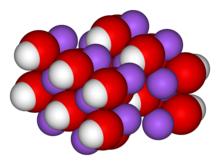 Sodium, Na
Oxygen, O
Hydrogen, H
|
|
 |
|
| Names | |
|---|---|
| IUPAC name
Sodium hydroxide[3]
|
|
Other names
|
|
| Identifiers | |
|
CAS Number
|
|
|
3D model (JSmol)
|
|
| ChEBI |
|
| ChemSpider |
|
| ECHA InfoCard | 100.013.805 |
| EC Number |
|
| E number | E524 (acidity regulators, ...) |
|
Gmelin Reference
|
68430 |
| KEGG |
|
| MeSH | Sodium+Hydroxide |
|
PubChem CID
|
|
| RTECS number |
|
| UNII |
|
| UN number | 1823 (solid) 1824 (solution) |
|
CompTox Dashboard (EPA)
|
|
| Properties | |
|
Chemical formula
|
NaOH |
| Molar mass | 39.9971 g/mol |
| Appearance | White, opaque crystals |
| Odor | odorless |
| Density | 2.13 g/cm3[4] |
| Melting point | 323 °C (613 °F; 596 K)[4] |
| Boiling point | 1,388 °C (2,530 °F; 1,661 K)[4] |
|
Solubility in water
|
418 g/L (0 °C) 1000 g/L (25 °C)[4] 3370 g/L (100 °C) |
| Solubility | soluble in glycerol, negligible in ammonia, insoluble in ether, slowly soluble in propylene glycol |
| Solubility in methanol | 238 g/L |
| Solubility in ethanol | <<139 g/L |
| Vapor pressure | <2.4 kPa (20 °C) 0.1 kPa (700 °C) |
| Acidity (pKa) | 15.7 |
|
Magnetic susceptibility (χ)
|
−15.8·10−6 cm3/mol (aq.)[5] |
|
Refractive index (nD)
|
1.3576 |
| Structure[6] | |
|
Crystal structure
|
Orthorhombic, oS8 |
|
Space group
|
Cmcm, No. 63 |
|
Lattice constant
|
a = 0.34013 nm, b = 1.1378 nm, c = 0.33984 nm
|
|
Formula units (Z)
|
4 |
| Thermochemistry[7] | |
|
Heat capacity (C)
|
59.5 J/(mol·K) |
|
Std molar
entropy (S⦵298) |
64.4 J/(mol·K) |
|
Std enthalpy of
formation (ΔfH⦵298) |
−425.8 kJ/mol |
|
Gibbs free energy (ΔfG⦵)
|
-379.7 kJ/mol |
| Hazards | |
| GHS labelling: | |
|
Pictograms
|
  |
|
Signal word
|
Danger |
|
Hazard statements
|
H290, H302, H314 |
|
Precautionary statements
|
P280, P305+P351+P338, P310 |
| NFPA 704 (fire diamond) |
 3
0
1
ALK
|
| Lethal dose or concentration (LD, LC): | |
|
LD50 (median dose)
|
40 mg/kg (mouse, intraperitoneal)[9] 140 - 340 mg/kg (rat, oral) 1350 mg/kg (rabbit, dermal) |
|
LDLo (lowest published)
|
500 mg/kg (rabbit, oral)[10] |
| NIOSH (US health exposure limits): | |
|
PEL (Permissible)
|
TWA 2 mg/m3[8] |
|
REL (Recommended)
|
C 2 mg/m3[8] |
|
IDLH (Immediate danger)
|
10 mg/m3[8] |
| Safety data sheet (SDS) | External SDS |
| Related compounds | |
|
Other anions
|
|
|
Other cations
|
|
|
Related compounds
|
|